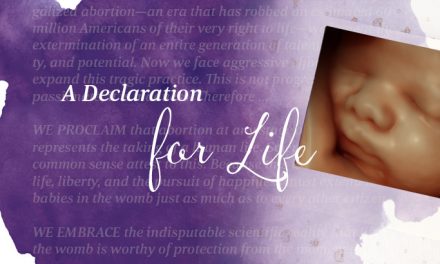Thanks to advances in science, medicine and technology, individuals with Down syndrome are living longer, healthier lives. In addition, better support programs and education interventions have allowed people who have the condition to develop their independence, succeed academically and as employees or volunteers. Despite the successes that the Down syndrome community has had in exposure and acceptance over the last 20 years, the statistics are alarming: at least 67% of preborn babies diagnosed with the Down syndrome are aborted in the U.S.
Why Is this Happening?
When Charles Darwin first introduced the theory of evolution and natural selection it had an incredible effect on biology. The acceptance of these two theories led scientists to believe human life is more about chance, happenstance and survival than divine intervention. The belief that human life had an inherent value as God’s only creation that reflects His image, as recorded in Genesis 1:27, was threatened by these theories. As the science of genetics continued to progress, there was an interest in using the principles of natural selection to help engineer the human population and remove “undesirable” elements from society. (To read more about the biblical perspective, see “The Sanctity of Human Life.”
Eugenics was a term first coined by Francis Galton as “the improvement of inborn qualities, or stock” of humans. Basically, it tries to create a better human society by using genetics and science as a basis for determining who should or should not reproduce. In the early 20th century, the practice became popular in the United States and Europe.
In the U.S., belief in eugenics led to abortions and the forced sterilization of people deemed unworthy of reproducing based on their perceived criminal, mental or physical deficiencies. In the 1927 Buck v. Bell decision, the U.S. Supreme Court upheld a Virginia state law legalizing forced sterilizations for people considered to have a “hereditary form of insanity or imbecility” living in state institutions. This ruling included individuals with Down syndrome who were overwhelmingly institutionalized during the first half of the 20th century. In the written decision, Judge Oliver Wendell Holmes famously declared in reference to one patient that “three generations of imbeciles are enough.” The Court has never overturned the decision though it is rarely referenced and not practiced in states.
The Buck v. Bell decision had far reaching effects. At the Nuremburg trials, Nazi doctors cited the U.S. Supreme Court decision in their defense to justify the mass murder of certain racial groups and those with psychiatric, neurological or physical disabilities, the first group targeted for “extermination.” As a result of the Nazi atrocities, the official eugenics movement was largely abandoned but its influence on science remained.
What’s Happening Now?
Eugenics isn’t a term that’s currently used in the medical community but its influence is still present. Due to the accuracy of prenatal testing, a baby in the uterus can be diagnosed with a disability or deformity, and potentially aborted as a result. It could be something treatable like cleft lip or a more severe condition. Women are also waiting longer to have children, which increases the use of prenatal testing and the chance of a diagnosis like Down syndrome. Depending on the result of the prenatal tests, families and mothers are often encouraged by medical professionals to abort, and most do.
Currently, 67-90% of preborn babies diagnosed with Down syndrome are aborted. (Determining the exact number is challenging since U.S. privacy laws make this data difficult to gather.) Those with disabilities may no longer be forcibly institutionalized, but instead they are often aborted before they have a chance to live.
Most abortion advocates continue to fight for abortion without restriction, which includes terminating preborn children because of disabilities, gender, or race. There has been some successful legislation in North Dakota, Indiana, and Louisiana aimed at protecting preborns with Down syndrome from abortion; however, Planned Parenthood and other organizations continue to support the mother’s desire to abort over the child’s right to live.
Opponents to legislation banning late-term abortions (20 weeks and beyond), like Planned Parenthood, promoted ads featuring mothers who aborted because of their child’s prenatal disability or deformity. Although most 20-week abortion bans are about fetal pain, abortion supporters often argue that the ban should not be in place so women can have a chance to abort if it is discovered that the child isn’t “perfect.”
What Will Happen in the Future?
Abortions based on a prenatal diagnosis of a disability will continue to increase without protective legislation. Already, there has been a 30% drop in the population of individuals living with Down syndrome in the United States. In countries like Iceland, a near 100% abortion rate for Down syndrome has resulted in the birth of only one or two children every year with the condition.
As science continues to advance, it’s likely that selective termination will become more arbitrary. The reason for aborting a pregnancy could be as trivial as gender, eye and hair color, food allergies, eating preferences or genetic predisposition for diseases like Alzheimer’s and certain cancers. Gender preference abortion is already a concern in some countries. In the U.K. some hospitals require families to pay an additional fee to learn the sex of the baby to avoid families aborting female preborns due to gender preference. It is estimated that more than 160 million girls have been lost to abortion across the world.
If selective abortion continues, then euthanasia of infants could be next. In the Netherlands, it is legal to euthanize a baby with a severe case of spina bifida or another disorder after the child is born if the doctors and family agree. The child could potentially live a long life, but living with a disability diminishes their value in the eyes of society.
Unless laws are passed to prevent it, the trend of aborting babies based on an in utero medical prognosis will likely continue, and the scope will expand to target more conditions. In essence, allowing science to decide who is worthy of life.
It is possible that one day there could be a world without Down syndrome, not because of medical advancements, but because abortion has become a permissible “treatment.”






